Anna Goes to Yellowstone
Pauline's nephew Richard and his daughter Anna
(age 9)
came to visit from England so we arranged a 3 day trip to Yellowstone
Park.
The park contains over half the world's thermal features and most of the
world's geysers,
but the animals are also a major attraction.
On our trip we saw the usual collection of geysers,
hot springs,
fumaroles and mud pots plus many elk,
100's of bison,
2 moose,
a bald eagle,
a coyote,
geese,
swans and many other animals.
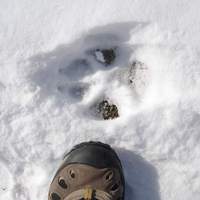
We started our Yellowstone trip by driving to the north entrance and
hiking to the
Boiling River.
Along the path we noticed some rather large,
fresh-looking footprints and Gary took a picture with his own size 9
(US)
foot as a reference.
After the hike we drove on to the Mammoth Ranger Station where the
ranger without hesitation identified our find as a
wolf footprint.
It was exciting to know we had been in a wolf's territory since wolves
generally stay far away from places people frequent.
We have only seen wolves through high-powered spotting scopes.
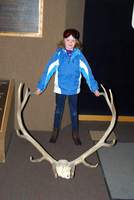
At the Mammoth Ranger Station we toured the exhibits so Anna could get a
preview of the animals we would be looking for during our 3 day stay.
The skull and antlers of a
6x6
bull elk was a good indication of the size of some of the animals.
Other exhibits included bison and mountain sheep horns plus antelope,
moose and elk antlers and fur from a number of animals.
Antlers are very heavy –
it's amazing the animals can keep their heads up.

From the Mammoth Ranger Station we headed east to the Blacktail Plateau
and were surprised to spot a moose making its way through the deep snow.
Generally,
moose are seen in the southern part of the park,
and then only rarely.
This one was almost at the northern boundary.
We watched the moose walk down into a stream gully,
where it joined a small moose –
probably its calf.
Seeing two moose was a real treat.
Moose appear to be very ungainly but are well adapted to walking in
marshes and snow;
note how the rear leg is able to lift almost clear of the snow to move
forward.

We continued on beyond Tower Junction,
where we saw many bison and elk up close.
On the way back to the Mammoth Terraces we were treated to a Yellowstone
Classic:
a bison jam that took us 45 minutes to get through.
The bison prefer to walk on the roads instead of through deep snow.
One does not want to stress wild animals during the Winter as that will
reduce their survival rate.
Besides,
who knows how they might react if one gave them a gentle nudge with the
car!
So one tries to act like a bison and squeeze slowly up through the herd
as opportunities present themselves.
The bison do seem to regard the car as one of the herd,
but they do not like being passed and will speed up or move in front of
the car to maintain order in the
“herd.”
We stayed the first night in the
Mammoth Lodge
at the Mammoth Terraces.
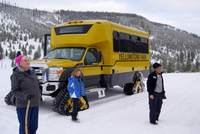
On the second day we boarded a snow coach for the 51 mile ride to Old
Faithful.
There are a variety of snow coaches;
the modern ones are conventional 4WD vehicles with their tires replaced
by tread mechanisms,
but there are still a number of classic
Bombardier snow coaches
in operation.
Snow coaches tend to fish-tail and wallow a lot on the snowy roads,
making for an interesting journey.
Along the way we made stops to see several sights.
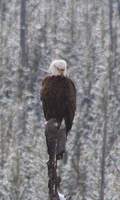
Another treat for us was sighting a Bald Eagle perched on the top of an
old tree left over from a forest fire.
He was keeping a close eye on the river below in hopes of catching a fish
dinner.
We stayed the second night at the
Snow Lodge
at Old Faithful.
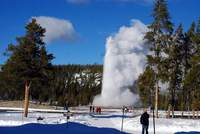
Staying overnight next to Old Faithful
gave us a long afternoon and the following morning to tour the area.
We saw Old Faithful erupt 5 times,
often with only a few other people present.
We hiked around the other geysers and hot springs in the afternoon.
The next morning Gary and Pauline took a longer hike to see some geysers
and hot springs they had not yet visited while Richard and Anna tried
their hand at cross-country skiing.
Our extended stay at Old Faithful gave Anna time to earn the Winter version
of the
Junior Ranger
patch.
After lunch on the third day we boarded the snow coach for the 51 mile
trip back to Mammoth,
followed by a drive home in a snow storm.
Some Comparisons:
The United Kingdom and Montana
|
|
United Kingdom
|
Montana
|
|
Land Area
|
93,278 sq miles
|
147,046 sq miles
|
|
Population
|
62 million
|
1 million
|
|
Cows
|
7.1 million
|
2.6 million
|
|
Highest Point
|
Ben Nevis
4,409 feet
|
Granite Peak
12,807 feet
|
|
Lowest Point
|
0 feet
|
1,820 feet
|
While Montana may be more than 1½
times the area of the United Kingdom,
the western 1/3 of the state is very mountainous and the eastern 2/3 is
arid plains.
All of the state is at a relatively high elevation and is subject to
very low temperatures in the Winter.
Thus,
Montana's geography and climate makes it quite unsuitable to support a
large population.
In fact,
even though cattle ranching is one of Montana's main industries,
the arid plains support fewer cattle per acre than the UK.






